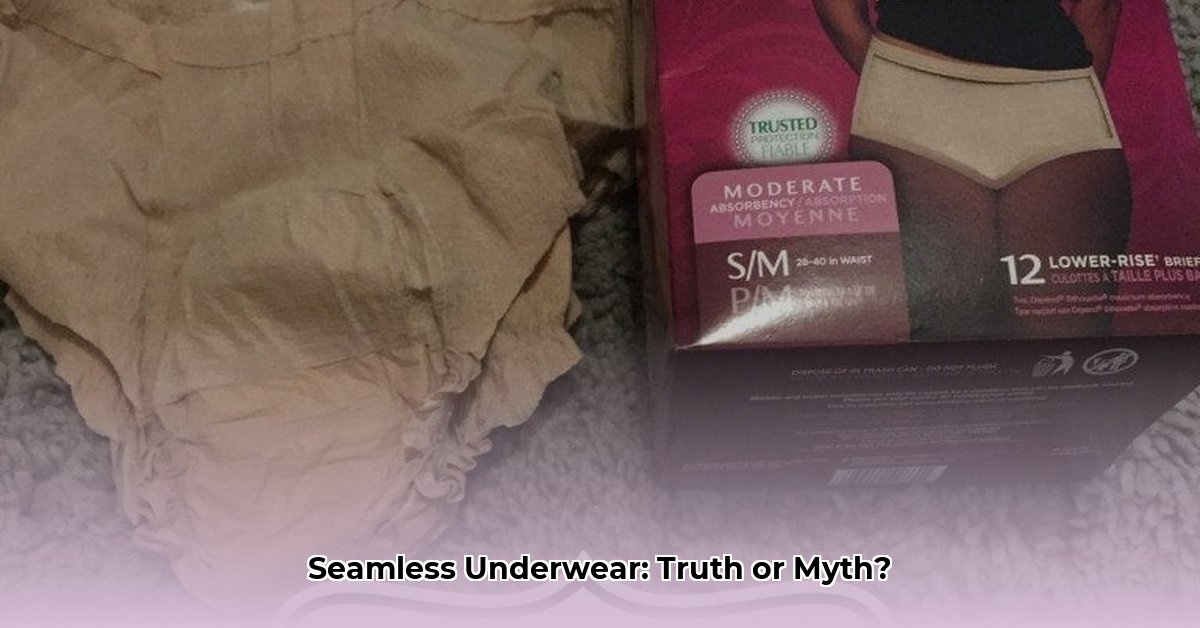Ever scrolled through Instagram and been bombarded with ads for “seamless” underwear, promising a smooth, line-free silhouette under even the tightest clothes? It sounds almost too good to be true, right? Well, in many cases, it is. Let’s unravel the marketing magic and uncover the reality behind the “seamless” claim.
The Illusion of “Seamless”: A Closer Look
The term “seamless” is often used liberally in the underwear industry, conjuring images of a single, continuous piece of fabric. However, the reality is often more nuanced. While some genuinely seamless undergarments exist, the vast majority achieve their smooth appearance through clever construction techniques that minimize rather than eliminate seams. Think of it as a carefully orchestrated illusion, designed to create the perception of seamlessness.
How “Seamless” Underwear Is Made: From Stitches to Bonds
Before we delve into the specifics, let’s quickly review some common seam types found in traditional underwear:
| Seam Type | Description | Comfort Level | Visibility | Durability |
|---|---|---|---|---|
| Flatlock | Two pieces of fabric are interlocked, creating a flat seam. | High | Low | Moderate |
| Cover Stitch | Multiple threads interloop, creating a strong, stable seam often used in activewear. | Medium | Medium | High |
| Overlock | A single thread wraps around the fabric edge; economical but can be bulky. | Low | High | Low |
Now, let’s explore the techniques used to create that “seamless” effect:
-
Bonding/Welding: This method uses heat or ultrasonic vibrations to fuse fabric edges together, creating a flat, smooth join. It’s like welding for fabric! While effective at minimizing bulk, bonded seams can sometimes be less durable than traditional stitching and may feel stiffer depending on the materials and adhesive used.
-
Laser Cutting: Lasers are used to precisely cut and seal fabric edges, resulting in clean, bonded finishes. This method offers exceptional accuracy and minimizes fraying. However, it can be more expensive than traditional methods.
-
Circular/Tubular Knitting: This technique creates a tube-like fabric, often eliminating the need for side seams. While not strictly “seamless,” it significantly reduces bulk and enhances comfort, similar to how socks are knit.
-
3D Knitting: This advanced technique knits entire garments in three dimensions, offering the potential for truly seamless construction and intricate designs. Think of it as a 3D printer for fabric. However, this technology is still relatively new and often comes with a higher price tag.
Spotting True Seamlessness: Becoming an Underwear Detective
So, how can you tell if underwear is truly seamless? Here are a few tips:
-
The Visual Inspection: Hold the garment up to the light. Can you see any seams? Where are they located? What do the edges look like? Bonded edges often have a slightly different sheen or texture than the surrounding fabric.
-
The Tactile Test: Run your fingers over the fabric. Can you feel any ridges, raised areas, or changes in texture? These are tell-tale signs of bonding or other joining methods.
Benefits and Drawbacks of “Seamless” Underwear
While the marketing hype around “seamless” underwear often overpromises, these garments do offer some genuine advantages:
-
Reduced VPL (Visible Panty Line): The primary appeal of “seamless” underwear is its ability to minimize visible lines under clothing. However, keep in mind that even bonded seams can sometimes be visible, especially under very tight or light-colored fabrics.
-
Enhanced Comfort: Fewer seams, or flatter seams, generally translate to less chafing and irritation. This is especially beneficial for sensitive skin or during physical activity.
-
Smooth Silhouette: The combination of construction techniques and stretchy fabrics creates a smooth, second-skin feel that many find appealing.
However, there are also some potential downsides to consider:
-
Durability: The delicate fabrics and bonding techniques used in some “seamless” underwear can make them less durable than traditionally constructed garments. They may be more prone to tearing or losing their elasticity over time.
-
Cost: “Seamless” underwear often comes with a premium price tag, reflecting the more complex manufacturing processes involved.
-
Breathability and Absorbency: While the thin, stretchy fabrics often used in seamless underwear can be breathable, they may not be as absorbent as traditional cotton. This could be a factor to consider depending on your individual needs.
The Bottom Line: Beyond the Hype
“Seamless” underwear can be a great option for those seeking comfort and a smooth silhouette. However, it’s crucial to understand that the term “seamless” is often used loosely. By understanding the different construction techniques and potential drawbacks, you can make informed decisions and choose underwear that truly meets your needs and preferences. Don’t simply fall for the marketing hype; do your research and become an informed consumer. After all, when it comes to underwear, comfort and confidence should always come first.
- How to Stop Apps From Running in the Background to Boost Your - December 1, 2025
- How To Move Apps On Your Droid For Better Organization - November 30, 2025
- How to Move Apps on Android for Better Organization - November 29, 2025










